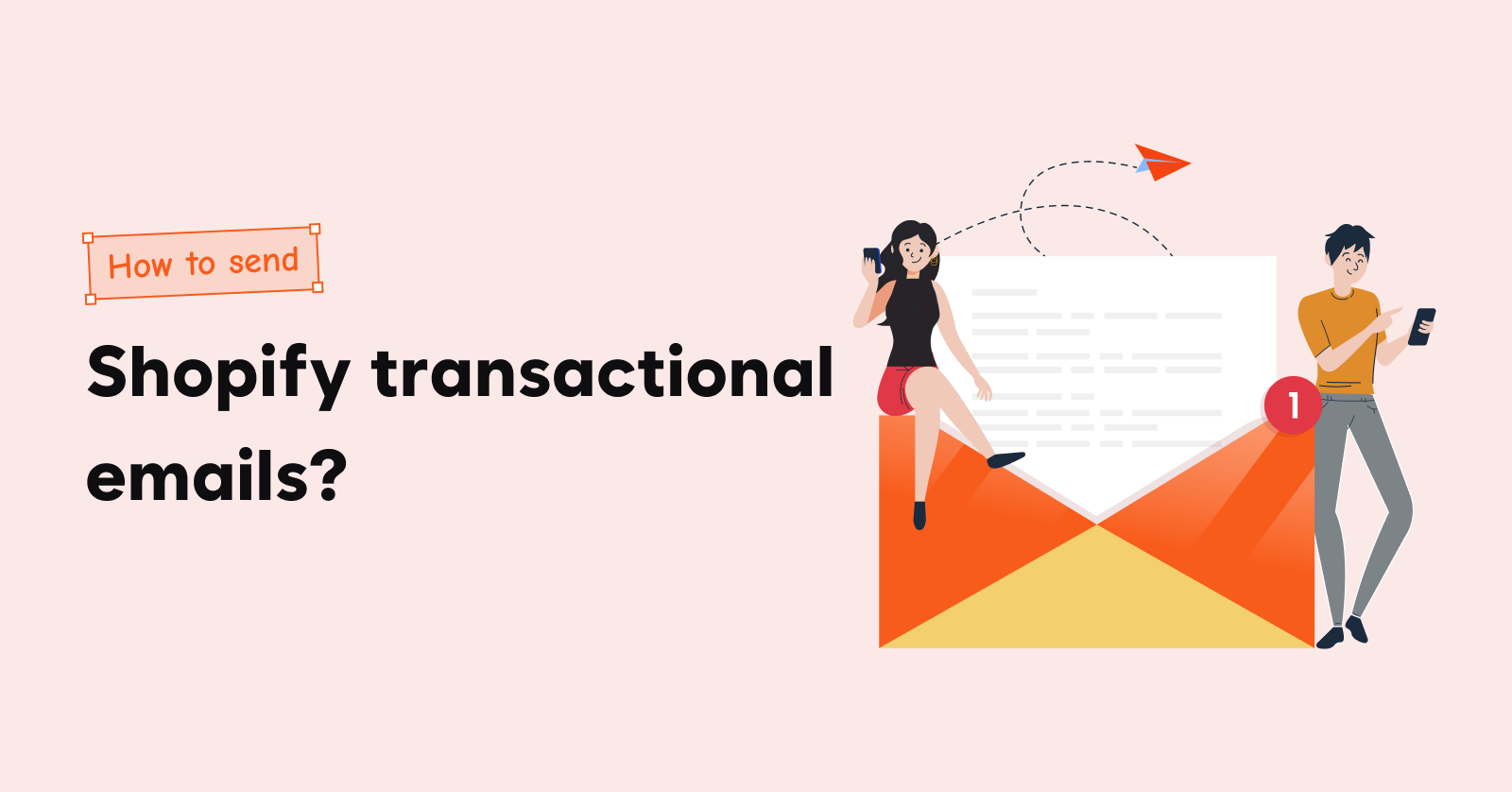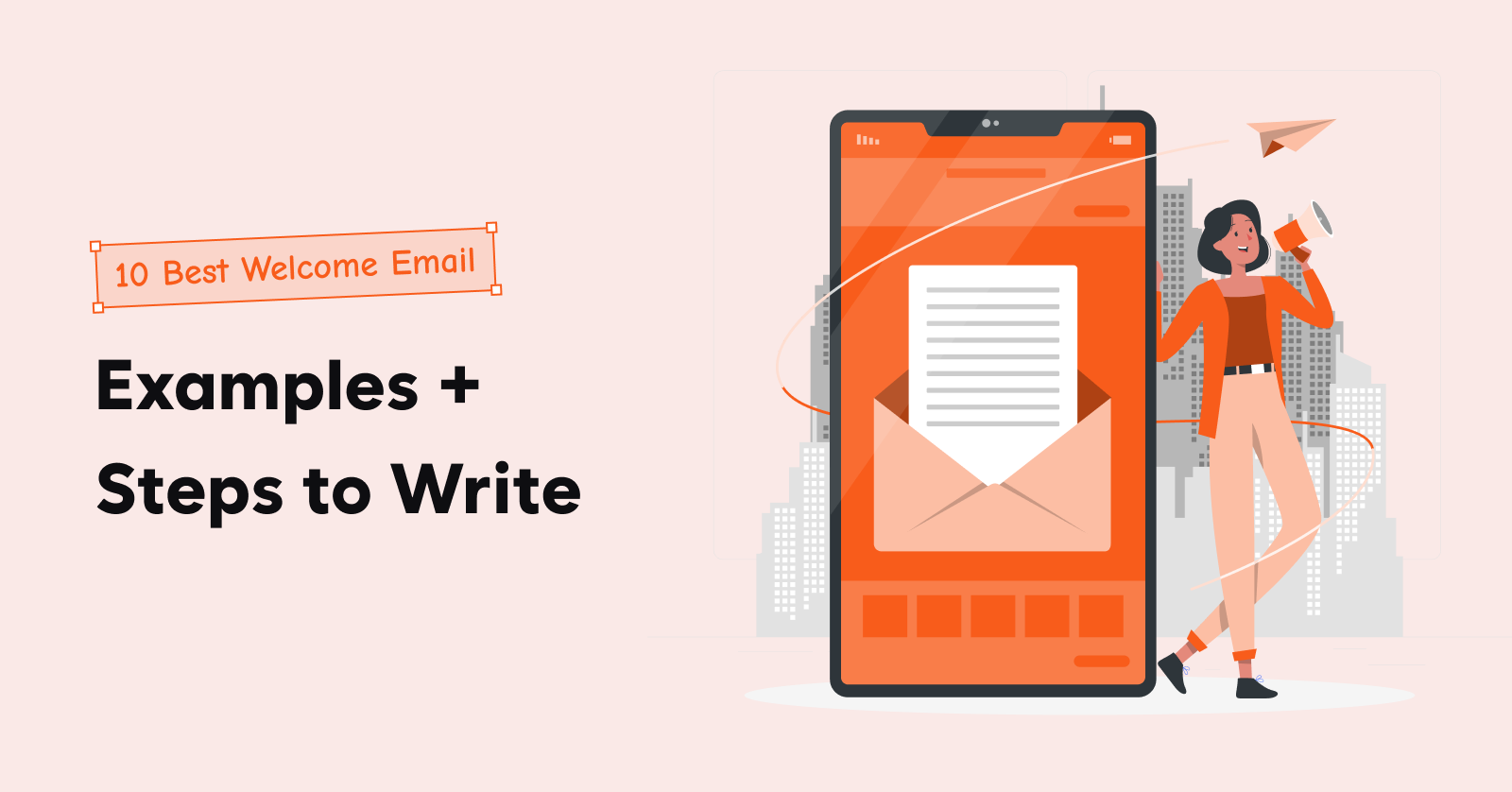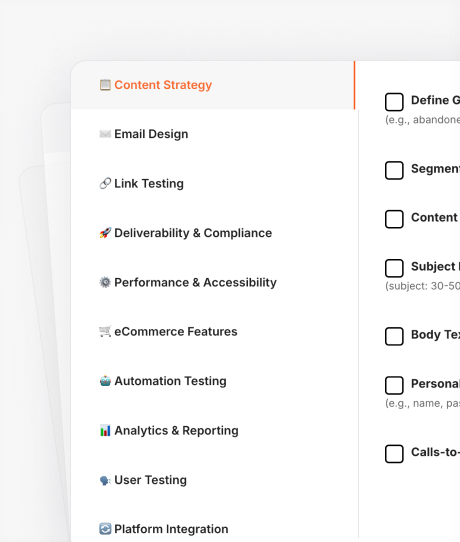How do some brands send the right email at the right time?
It is no coincidence—it’s AI!
When handling thousands of subscribers, delivering customized emails to every subscriber becomes difficult.
Poor timing, data overload, and lack of personalization—are all challenges marketers face while managing dozens of emails.
Marketing teams can further strengthen their outreach by ensuring consistent messaging across multiple platforms; one proven approach is to align email and social media channels for a cohesive, multi-channel marketing strategy that maximizes engagement.
Fortunately, with AI, you can analyze customer data, optimize email campaigns, and leverage automation to send responsive emails timely. AI streamlines the process of targeted outreach and builds deeper connections with customers. 41.29% of marketers report an improvement in revenue with AI-driven email campaigns.
In this article, we’ll talk about the role of AI in email marketing and explore the best AI email marketing tools you can employ. Let’s dive in!
Understanding AI in Email Marketing
The use of AI in general is implementing machine learning and natural language processing to engage deeply with the audience through human-like conversations.
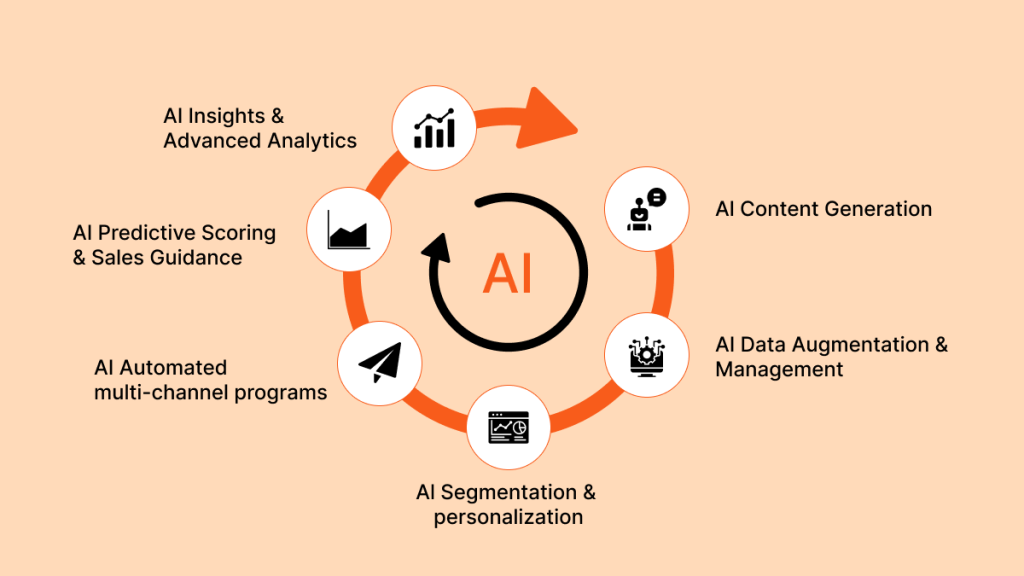
Instead of relying on guesswork, AI analyzes data in real-time to optimize email campaigns, ensuring that each interaction is relevant, timely, and personalized.
Traditional email marketing often involves assumptions that lead to ineffective campaigns, such as:
- Assuming the best time to send emails rather than analyzing user behavior.
- Randomly using subject lines without proper A/B testing.
- Taking a bet on self-assumed customer data instead of accurate data analytics, resulting in weak content personalization.
- Relying on vague performance metrics instead of tracking key metrics like open rates, click-through rates, and unsubscribe rates.
Let’s break down the role of AI in email marketing for a better understanding.
1. Hyper-personalization
While personalization deals with basic customer data like name, location, and historical data, hyper-personalization goes beyond traditional datasets.
Hyper-personalization leverages transactional data, behavioral patterns, device type, and social media activity in real time. AI continuously learns from this data to predict customer needs and tailor email experiences dynamically.
Let’s take Amazon as an example:
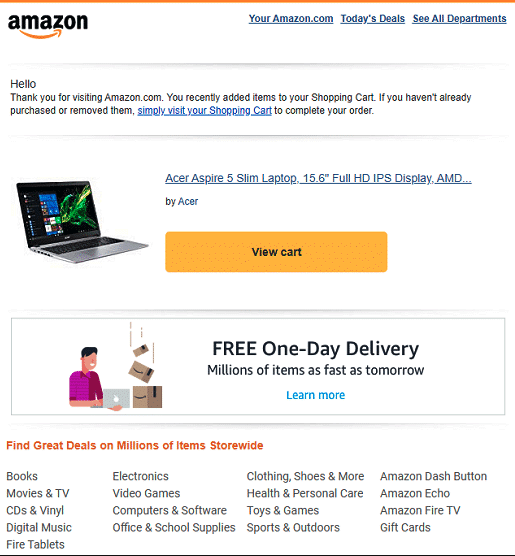
- Amazon leverages AI’s deep learning to analyze browsing history, transaction history, clicked links, wish lists, and shopping carts.
- Following the gathered data, Amazon curates “Top picks for you”, “Special offers”, and “You might also like” subject lines.
- Customers receive notifications about the latest deals via emails with unique pre-headers and subject lines that spark interest.
- This promotes tailored shopping experiences and encourages customers to take immediate action.
Hyper-personalized emails generally look like this:
Example 1 – Birthday Special: “Happy Birthday, {First Name}! To celebrate, we’re offering you a 20% discount on all purchases made today. Enjoy your special day with us!”
Example 2 – Loyalty Rewards: “Congratulations, {First Name}, you’ve reached {Tier Level} in our loyalty program! As a reward, enjoy exclusive access to early sales and a 10% discount on your next purchase”.
Pro tip: To take personalization beyond emails, employ AI voice cloning. It can create virtual assistants that mimic human-like tones, capturing emotions and nuances for a more immersive customer experience on websites and apps.
2. Enhanced segmentation and targeting
Integration of AI helps to create a customer profile by analyzing the customer’s demographics, behavior, requirements, and priorities to create highly targeted email campaigns. AI dynamically categorizes customers based on real-time data, ensuring that emails reach the right audience at the right time with the most relevant content. AI-driven email segmentation happens in four stages:
- Data collection: AI gathers rich customer insights from multiple sources, including:
- Purchase history – Frequency, recency, and spending habits.
- Online behavior – Website visits, clicked links, and engagement levels.
- Browsing history – Pages viewed, time spent, and cart activity.
- Sentiment analysis – Social media interactions and feedback.
- Segment creation: Based on the collected data, segments are created to group similar customers into targeted segments to improve email personalization.
There are mainly four kinds of segmentation:- Demographic- Age, gender, income, job role, etc.
- Psychographic- Interests, values, and lifestyle.
- Geographic- Location-based targeting.
- Behavioral- Purchase patterns, engagement, and loyalty.
- Refinement: By regularly tracking the evolving customer behavior, segments are updated to refine campaign strategies. This ensures that email campaigns remain relevant and impactful over time.
For example, Forever 21 leverage AI to deliver hyper-personalized emails that:
- Offer discounts based on customer purchase history.
- Highlight product categories aligned with past interests.
- Showcase limited-time promotions to create urgency.

Platforms like retainful.com offer email segmentation tools to group customers based on their unique interests and actions. The tool undergoes all three stages to target every type of customer by sending relevant messages mentioning exclusive offers and product recommendations.

3. Optimized send times & frequency
There is no point in sending personalized emails if they are destined to get lost in the inbox. By analyzing user activity patterns and peak active hours, AI suggests the best time to send emails.
Here’s how it works:
- Analyzing past engagement – AI tracks a recipient’s open and click behavior over time, identifying when they are most active.
- Identifying time zones and demographics – AI automatically adjusts email schedules based on the recipient’s time zone and location-specific behavior.
- Predictive modeling – Using machine learning, AI creates a customer profile analyzing their purchase behavior, website activity, and engagement times to predict optimal send times.
This boosts customer retention and avoids overloading their inbox with promotional brand emails.
4. AI-generated subject lines & content
AI tools gather crucial data from customer feedback and past campaign performance to create effective subject lines. It leverages machine learning and natural language processing to write emotional phrases, “how-to” statements, urgency cues, and open-ended questions.
Here’s how it works:
- Content analysis: AI analyzes keywords, tone, and context to define the intent of the message.
- Ideation: Ideas are generated using advanced algorithms for creating distinct subject lines to serve a specific purpose.
- Subject-line generation: AI combines ideas with data to generate compelling subject-line variations incorporating emotional triggers. AI tools also take visual elements into account, including fonts, to ensure subject lines are not only compelling in content but also visually appealing
- A/B testing: Using A/B testing, the top-performing variation is identified to optimize emails and maximize engagement.
Some classic subject-line examples include:
- “We saved your cart for you”
- “Your shopping bag misses you!”
- “Complete your order for [Product Name] today!”
5. Predictive analytics for better conversions
Predictive analysis is the evaluation of customer behavior to forecast future behavior and trends.
Netflix is a prime example of using predictive analysis in action. The brand recommends new shows and movies via email to users based on their watch history. They also send reminders about unfinished episodes, movie premiers, and “Leaving Soon” alerts.
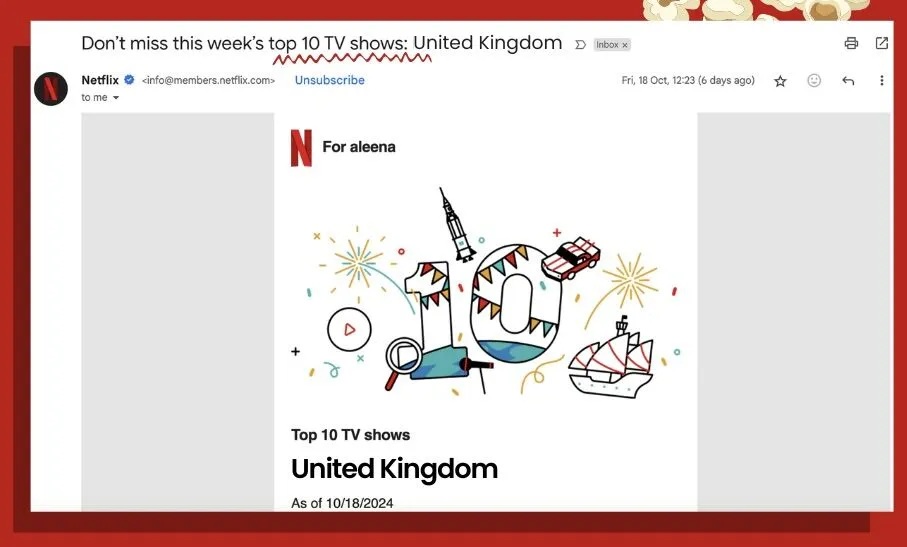
Predictive analysis works in three stages:
- Awareness stage: The predictive model analyzes the subscriber’s historical data to customize emails with a free trial link to create awareness.
- Consideration stage: When the subscriber uses the free trial, the algorithm immediately examines their feature usage and session frequency to send an email mentioning the success stories of past customers.
- Conversion stage: Now, depending upon the action taken after receiving the email, the model predicts the customer’s interest in advanced features. An email mentioning premium benefits and special discounts is sent to finalize the conversion.
How AI Automates & Optimizes Email Workflows
AI plays a significant role in automating and optimizing emails. A common example is when customers receive a prompt email just after completing a purchase such as:
- “Order Confirmed” – Providing reassurance and purchase details.
- “Order Shipped” – Keeping customers informed and engaged.
Here’s how AI automates and optimizes email workflows:
AI-powered email automation
AI scans the customer profile to streamline email content creation and improve campaign performance. AI has a key role in automating:
- Segmentation
- Email personalization
- Scheduling
- Time optimization
- Follow-ups
Additionally, AI-powered systems can facilitate email translation, ensuring that emails are accurately localized for different regions. This ensures your messaging reaches a global audience in their preferred language, improving engagement and customer satisfaction. Email marketing platforms powered by AI further enhance this process by automating campaign management, A/B testing, and performance tracking, making marketing efforts more efficient and data-driven.
Email automation tools schedule emails following the collected customer data. This includes follow-ups, greetings, and prompt responses to deliver timely communication.
AI chatbots & email integration
AI-powered chatbots generate automated responses to generic email inquiries by integrating with email systems. Let’s break down their key role:
- AI chatbots identify complex queries and route them to appropriate human agents.
- They analyze incoming emails and prioritize them based on urgency level, customer tenure, and keywords.
- Chatbots integrate with emails (often called email bots) to deliver timely responses and gather customer feedback. For instance, when a customer raises a ticket through a chatbot, email systems trigger an immediate email response to address the ticket.
- AI regularly monitors the performance of chatbot-email integrations to identify gaps and increase efficiency.
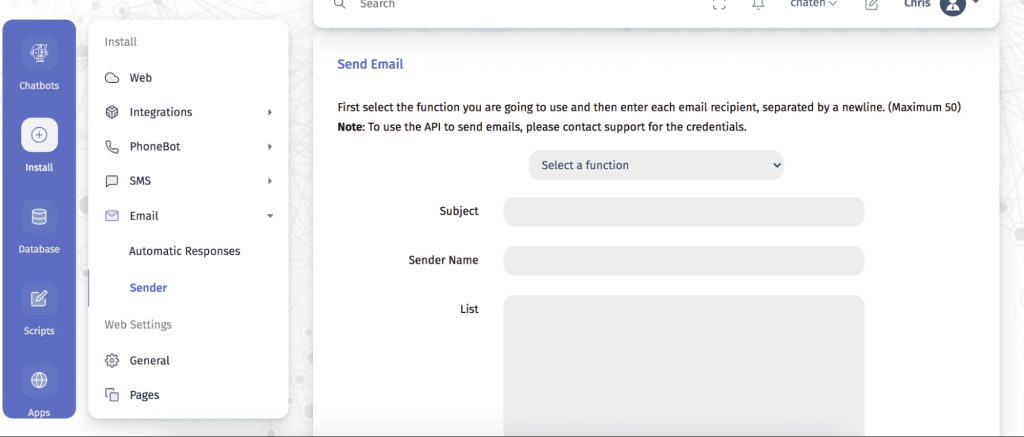
Integration of chatbots with email systems streamlines communication by handling routine tasks and nurturing leads by prioritizing urgent queries. This reduces human intervention and boosts customer engagement.
Best AI Tools for Email Marketing in 2025
Amidst the growing inclination towards AI, AI tools have become popular for streamlining communication and launching effective email campaigns. In fact, 51% of marketers believe AI-powered email campaigns yield more effective results than traditional practices.
Mentioned below are the best AI tools for email marketing you can employ in 2025:
1. HubSpot AI email writer
The AI email writer is built into the HubSpot marketing dashboard, making it easy to integrate across platforms using HubSpot CRM.

- The tool customizes email marketing templates, highlights commands, and uses strong CTAs based on customer data analysis.
- It offers an aggregated marketing dashboard, allowing you to monitor your email marketing efforts.
- You can choose your favorite design template and modify it according to the email’s objective.
- The HubSpot CRM database automatically tracks campaign data to measure the effectiveness of campaigns.
The key feature is – efficient personalization through:
- Customization options
- Tone and style adaptation
- Real-time editing
- Automated subject-line generation
- Multilingual support
2. Seventh sense
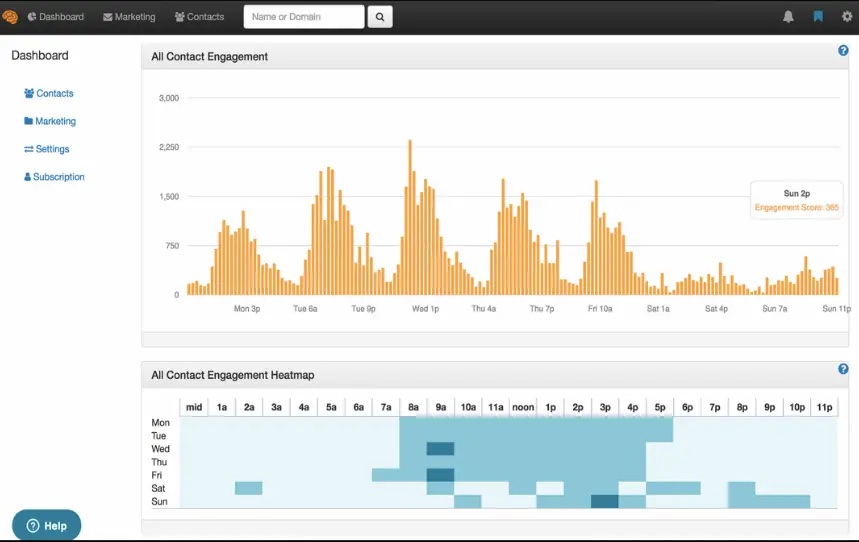
Seventh Sense uses AI to optimize email frequency and personalize email delivery time to achieve the primary aim—better customer engagement. Some additional features include:
- Email throttling: Throttling refers to limiting the number of emails sent in a specific period, enabling you to pause campaigns and avoid being flagged as spam.
- Increase deliverability: Sending emails at optimized times increases the chances of emails reaching the recipient’s inbox.
- Knowledge transfer: Enables marketing and sales teams to collect and analyze customer interaction data.
- Email frequency distribution: AI segments customers, following which automated emails are sent at a predetermined frequency to avoid bounces.
3. Phrasee
Phrasee is popular for its generative AI capabilities for creating compelling subject lines and high-performing email copy.
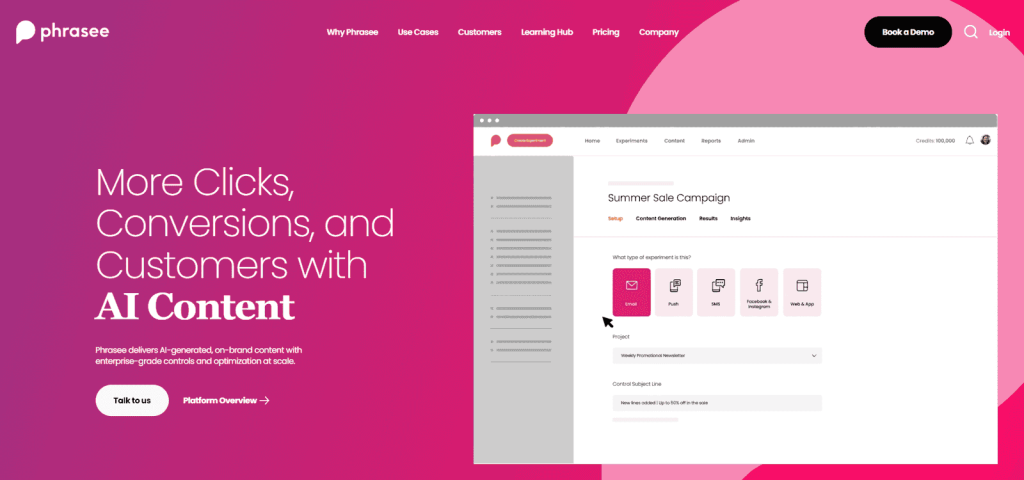
Here’s how it enhances email campaigns:
- Phrasee mirrors the tone and style of your brand’s voice for consistent branding.
- The tool automates A/B testing to test email variations, identifying the most effective variation.
- The Phrasee scoreboard tracks the performance of emails and implements predictive analysis to forecast future trends and formats.
- Marketing teams can apply omnichannel marketing strategies by leveraging the language generation system to optimize content for multiple platforms.
In conclusion, Phrasee helps marketers increase clicks, conversions, customer retention, and brand loyalty.
4. Drift email
Drift email primarily focuses on conversational marketing through AI-powered chatbots to engage with website visitors in real time.
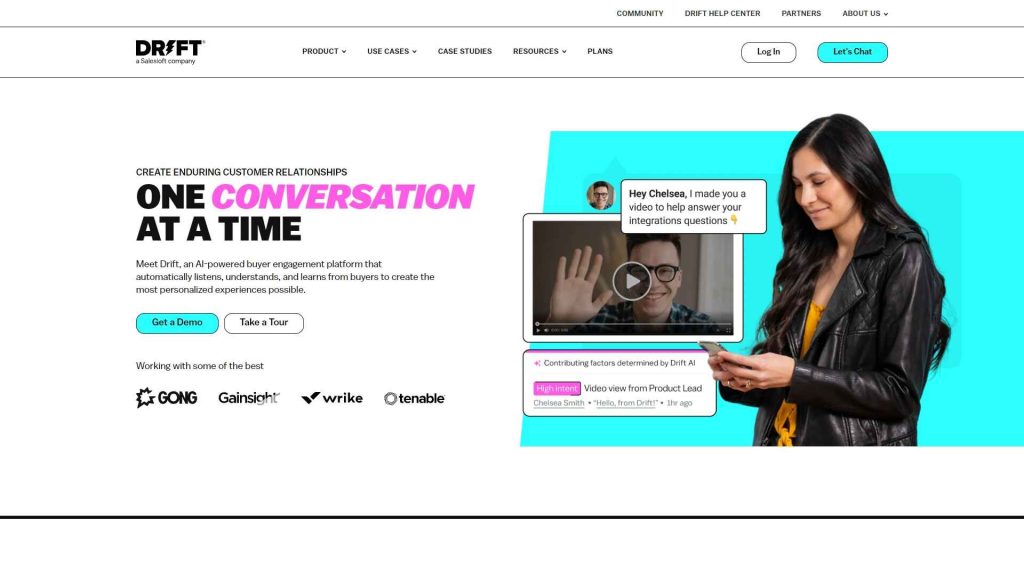
So, what is the role of Drift email in email campaigns?
- The tool integrates with the CRM database to regularly update contact details to promote data consistency in emails.
- You can apply smart filters to stop delivering emails to people who are already in conversation with the sales department.
- Drift triggers email campaigns following customer actions. For instance, if a chat is incomplete, the tool sends follow-up emails at optimal hours to re-engage the lead.
- Through real-time data analytics, Drift ensures every active visitor receives a personalized email, resulting in higher engagement and user satisfaction.
The responses are personalized based on browsing history and preferences. This enhances engagement, leading to meaningful customer relationships.
5. Optimail
Optimail offers AI-driven email automation based on real-time customer actions, delivering timely and relevant emails.

Let’s have a look at its key features:
- Optimail offers hyper-personalization by leveraging the real-time data of customers.
- It is designed to conduct regular test variations and identify the message that yields the most desired results.
- The tool is equipped to integrate with existing infrastructures and process large customer datasets.
- Using machine learning, Optimail learns from customer feedback and launches automated email campaigns.
Best Practices for Implementing AI in Email Marketing
Although AI tools have evolved and offer great assistance in email marketing, it is important to implement AI strategically.
Here are some best practices for implementing AI in email marketing:
Start small & scale gradually
- Before relying entirely on AI, start with one feature like customer segmentation or optimizing send times.
- Understand the features and gradually use advanced AI features such as content personalization and automated A/B testing.
- Measure the performance using key email marketing metrics like open rates, click-through rates, and bounce rates.
Monitor AI-generated content
- Review AI-generated email copy, subject lines, and customized offers to check whether they align with your brand’s voice or not.
- Use customer feedback to train AI models to craft compelling content for email campaigns.
- Prioritize A/B testing to check which elements of the email are working and generating results.
Use AI with human oversight
- Assign customer support teams to oversee AI-driven workflows and manually review critical outputs.
- Include human creativity in the process of crafting emails. For example, use AI to generate ideas and modify them by giving a personal touch.
- Determine the number of tasks that must be automated and the key areas where human intervention is required.
Maintain data privacy & compliance
- Use trusted platforms to store and process customer data. Look for key features like data encryption and anonymization.
- Maintain transparency through privacy policies to inform customers about how their data is used in email campaigns.
- Revise privacy laws to audit email marketing practices and ensure compliance with the latest rules and regulations.
The Future of AI in Email Marketing: Smarter, Faster, and More Impactful
AI has transformed email marketing, making campaigns more personalized, efficient, and data-driven. From crafting personalized email copy, and compelling subject lines to automating responses and optimizing send times, AI plays an important role in building deep customer relationships.
As AI evolves, the opportunities for launching tailored email campaigns are all set to grow. You must stay ahead of the curve by leveraging AI and automation.
Visit retainful.com today and explore its impactful AI-driven features to boost the engagement and conversion rates of your emails.
